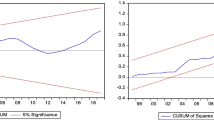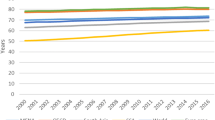Abstract
This study explores the linkage between human capital particularly life expectancy and literacy and GDP per capita in selected South Asian economies. The study uses annual panel data of Bangladesh, India, Nepal, Pakistan, and Sri Lanka for the period 2000–2016, published by the World Bank. It applies panel unit root test, Pedroni cointegration test, panel autoregressive distributed lagged (ARDL) bound test, and Dumitrescu-Hurlin panel causality test. The result from Pedroni cointegration test and panel ARDL bound test revealed that GDP per capita (LGDPC), life expectancy at birth (LEB), and adult literacy rate (ALR) have both long-run as well as short-run association. Dumitrescu-Hurlin panel causality test evidences bidirectional causality between LEB and LGDPC, ALR and LGDPC, and ALR and LEB. It means that life expectancy at birth causes GDP per capita, and increased per capita income causes life expectancy to rise through better health care. Adult literacy rate causes GDP per capita income positively; enhanced per capita income causes adult literacy rate to rise through spending on education. Lastly, literacy causes life expectancy through better job, higher earning, and healthier behavior, while life expectancy causes literacy through longer and better life, leading to more productivity and resultant incremental income enabling to spend more on education. Therefore, the policy makers of South Asian countries should promote further quality education and better health through human capital formation to achieve sustainable growth in per capita income.
Similar content being viewed by others
Notes
The selected countries are Bangladesh, India, Nepal, Pakistan, and Sri Lanka out of the eight member countries of South Asian Association for Regional Cooperation (SAARC). The SAARC was formed on 8 Dec 1985 as an intergovernmental and geopolitical union of eight nations in the South Asia.
HCI quantifies the amount of human capital a child born today will acquire by the end of secondary school, given the risks to poor health and poor education that prevail in the country where s/he is born. It contains three main ingredients, reflecting building blocks of the human capital of the next generation: Survival, whether the kids born today will survive to school age; school, level of school they will complete and how much they will learn; and health, whether kids leave school in good health and be ready for further learning and/or work (World Bank 2019a).
For example, during 2010–2017 on average 67, 68, 82, 64, and 82% of the total population lived in rural areas in Bangladesh, India, Nepal, Pakistan, and Sri Lanka, respectively (World Bank 2019).
References
ADB. (2017). Human capital development in South Asia: Achievements, prospects, and policy challenge, Philippines. P., 1.
Barro, R. J. (1991). Economic growth in a cross section of countries. The Quarterly Journal of Economics, 106(2), 407–443.
Bassanini, A., & Scarpetta, S. (2002). Does human capital matter for growth in OECD countries? A pooled mean-group approach. Economics Letters, 74(3), 399–405.
Becker, G. S. (1975). Human capital: A theoretical and empirical analysis, with special reference to education (2nd ed.). New York: Columbia University Press for NBER.
Bloom, D. E., Canning, D., & Sevilla, J. (2004). The effect of health on economic growth: A production function approach. World Development, 32(1), 1–13.
Cutler, D. M., & Lleras-Muney, A. (2010). Understanding differences in health behaviors by education. Journal of Health Economics, 29(1), 1–28.
Dumitrescu, E.-I., & Hurlin, C. (2012). Testing for Granger non-causality in heterogeneous panels. Economic Modelling, 29(4), 1450–1460.
Engle, R. F., & Granger, C. W. J. (1987). Cointegration and error correction: Representation, estimation and testing. Economertica, 55(March), 251–276.
Granger, C. W. J. (1969). Investing causal relationships by econometric models: Cross spectral methods. Econometrica, 37(3), 424–438.
Hongyi, L. I., & Huang, L. (2009). Health, education, and economic growth in China: Empirical findings and implications. China Economic Review, 20(3), 374–387.
Ho, S. Y. (2018). Analysing the sources of growth in an emerging market economy: The Thailand experience. International Journal of Sustainable Economy (IJSE), 10(4), 2018.
Islam M S and Muneer S (2018). Human Development and Economic Growth Nexus: A Comparative Study between Bangladesh and Pakistan, Pacific Business Review International, Volume 11 Issue 3, September 2018.
Lucas Jr., R. E. (1988). On the mechanics of economic development. Journal of Monetary Economics, 22(1), 3–42.
Maitra, B., & Mukhopadhyay, C. K. (2012). Public spending on education, health care and economic growth in selected countries of Asia and the Pacific. Asia-Pacific Development Journal, 19(2), 19–48.
Mankiw, N. G., Romer, D., & Weil, D. N. (1992). A contribution to the empirics of economic growth. The Quarterly Journal of Economics., 107(2), 407–437.
Mincer, J. (1974). Schooling, experience and earnings. New York: Columbia University Press.
Musila, J. W., and Belassi, W. (2004). The impact of education expenditures on economic growth in Uganda: Evidence from time series data. The Journal of Developing Areas, 123-133.
Ni, S., & Wang, X. (1994). Human capital and income taxation in an endogenous growth model. Journal of Macroeconomics, 16(3), 493–507.
OECD, (2001) [online]. http://www.oecd.org/education/innovation-education/1870573.pdf (Accessed 5 December 2018).
Omojimite, B. U. (2010). Education and economic growth in Nigeria: A Granger causality analysis. African Research Review, 4(3a), 90–108.
Psacharopoulos, G., & Woodhall, M. (1993). Education for development. Oxford, UK: Oxford University Press.
Pedroni, P. (1999). Critical values for cointegration tests in heterogeneous panels with multiple regressors. Oxford Bulletin of Economics and Statistics, 61, 653–670.
Pedroni, P. (2004). Panel cointegration; asymptotic and finite sample properties of pooled time series tests, with an application to the PPP hypothesis. Econometric Theory, 20, 575–625.
Pesaran, M. H. and Y. Shin (1999). An autoregressive distributed lag modelling approach to cointegration analysis”. Chapter 11 in S. Strom (ed.), econometrics and economic theory in the 20th century: The Ragnar Frisch centennial symposium. Cambridge University Press, Cambridge.
Pesaran, M. H., Shin, Y., & Smith, R. (2001). Bounds testing approaches to the analysis of level relationships. Journal of Applied Econometrics, Vol., 16(3), 289–326.
Phillips Peter, C. B., & Perron, P. (1988). Testing for a unit root in time series regression. Biometrika, 75(2), 335–346.
Ranis, G., & Stewart, F. (2005). Dynamic links between the economy and human development. UN.
Romer, P. M. (1990). Endogenous technological change. Journal of political Economy, 98(5, part 2), S71–S102.
Roopchund, R. (2017). Understanding the contribution of human capital for the competitiveness of Mauritius. International Journal of Competitiveness, 1(2), 119–135.
Saad, W., & Kalakech, K. (2009). The nature of government expenditure and its impact on sustainable economic growth. Middle Eastern Finance and Economics, 1(4), 39–47.
Sakamoto, A., & Powers, D. A. (1995). Education and the dual labor market for Japanese men. American Sociological Review, 222–246.
Schultz, T. W. (1961). Investment in human capital. The American Economic Review, 51(1), 1–17.
Suri, T., Boozer, M. A., Ranis, G., & Stewart, F. (2011). Paths to success: The relationship between human development and economic growth. World Development, 39(4), 506–522.
UNDP (2018). Human development indices and indicators, 2018 statistical update, pp.31-32.
World Bank. (2019). World development report 2019: The changing nature of work. DC: Washington.
World Bank (2019a). https://data.worldbank.org/indicator/NY.GDP.PCAP.CD?locations=Z4-8S-Z7 retrieved on February 01, 2019.
Author information
Authors and Affiliations
Corresponding author
Ethics declarations
Conflict of Interest
The author declares that there is no conflict of interest.
Additional information
Publisher’s Note
Springer Nature remains neutral with regard to jurisdictional claims in published maps and institutional affiliations.
Rights and permissions
About this article
Cite this article
Islam, M.S. Human Capital and Per Capita Income Linkage in South Asia: A Heterogeneous Dynamic Panel Analysis. J Knowl Econ 11, 1614–1629 (2020). https://doi.org/10.1007/s13132-020-00637-1
Received:
Accepted:
Published:
Issue Date:
DOI: https://doi.org/10.1007/s13132-020-00637-1




